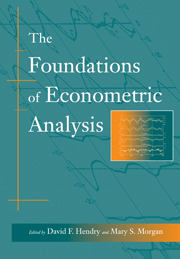Book contents
- Frontmatter
- Contents
- Preface
- Acknowledgements
- Introduction
- Bibliography
- I The Emerging Role of Econometrics in Economics
- II Early Time-Series Analysis
- III Applied Econometrics and the Identification Problem
- IV The Evolution of Statistical Thinking in Econometrics
- V Dynamic Models
- VI The Tinbergen Debate
- 33 Statistical Testing of Business Cycle Theories: A Method and its Application to Investment Activity (League of Nations, Geneva, 1939, vol. I, pp. 34–43, 47–64)
- 34 Professor Tinbergen's Method (Review of Tinbergen (1939), vol. I, Economic Journal vol. 49, 1939, pp. 558–68)
- 35 Mr Keynes on the Statistical Verification of Business Cycle Theories (unpublished, 1940)
- 36 Econometric Business Cycle Research (Review of Economic Studies, vol. 7, 1940, pp. 73–80)
- 37 Autonomy of Economic Relations (League of Nations Memorandum, 1938) and J. Tinbergen's reply (both unpublished)
- VII Structure and Simultaneity
- VIII The Probabilistic Revolution
- IX Exogeneity
- Index
36 - Econometric Business Cycle Research (Review of Economic Studies, vol. 7, 1940, pp. 73–80)
Published online by Cambridge University Press: 05 June 2012
- Frontmatter
- Contents
- Preface
- Acknowledgements
- Introduction
- Bibliography
- I The Emerging Role of Econometrics in Economics
- II Early Time-Series Analysis
- III Applied Econometrics and the Identification Problem
- IV The Evolution of Statistical Thinking in Econometrics
- V Dynamic Models
- VI The Tinbergen Debate
- 33 Statistical Testing of Business Cycle Theories: A Method and its Application to Investment Activity (League of Nations, Geneva, 1939, vol. I, pp. 34–43, 47–64)
- 34 Professor Tinbergen's Method (Review of Tinbergen (1939), vol. I, Economic Journal vol. 49, 1939, pp. 558–68)
- 35 Mr Keynes on the Statistical Verification of Business Cycle Theories (unpublished, 1940)
- 36 Econometric Business Cycle Research (Review of Economic Studies, vol. 7, 1940, pp. 73–80)
- 37 Autonomy of Economic Relations (League of Nations Memorandum, 1938) and J. Tinbergen's reply (both unpublished)
- VII Structure and Simultaneity
- VIII The Probabilistic Revolution
- IX Exogeneity
- Index
Summary
Introductory
In recent years various attempts have been made to construct econometric models of the business cycle mechanism. Some of them are very simple, others more complicated; some pay more attention to the mathematico-economic set-up, others give special care to a statistical determination of the coefficients involved. The latter group is notable for, in particular, the model by Radice of the post-war United Kingdom, that by De Wolff of post-war Sweden, and my own attempts for the Netherlands and the United States. As far as I am myself concerned, a ‘model under construction’ is that for the United Kingdom between 1870 and 1914.
An essential feature of an econometric model is, I think, that it combines mathematico-economic treatment with statistical measurement of some type. The ultimate objectives of these models are the same as of any system of business cycle research, viz. (i) to explain historical events; (ii) to forecast future developments under certain conditions; and (iii) to indicate the probable consequences of measures of business cycle policy. Within the framework of these ultimate objectives, one may distinguish more proximate objectives. These may be separately stated for the economic and the statistical parts of the task. The objectives of the economic part are, to my mind:
(a) to clarify notions and assumptions of various theories and to localise differences of opinion;
(b) to find the complete implications of any set of assumptions as to type of movement resulting, influence of given types of policy, etc.
- Type
- Chapter
- Information
- The Foundations of Econometric Analysis , pp. 399 - 406Publisher: Cambridge University PressPrint publication year: 1995

